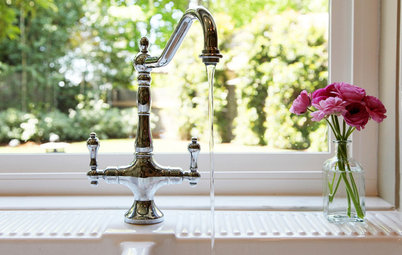Everything You Need to Know About Farmhouse Sinks
They’re charming, homey, durable, elegant, functional and nostalgic. Those are just a few of the reasons they’re so popular
Being from Ireland and having included the beautiful Belfast farmhouse sink in many traditional country and farmhouse kitchen designs, I have a bit of a soft spot for farmhouse-style sinks. The farmhouse sink originated in a time when there was no running water. The idea behind the sink was that it was a place to hold large amounts of water, which was fetched by hand from nearby wells, lakes and rivers.
The two original farmhouse-style sinks emerged in Ireland and Britain in the late 17th century. They were of similar design but had their own characteristics. The Belfast sink was deep and had an overflow so that excess water could easily drain away instead of flowing over the sides. The London sink — designed for an area where water was scarce and therefore more precious — was shallower. It had no overflow so that every last drop could be kept inside the sink.
If you’re thinking about choosing a farmhouse-style sink for your kitchen, here’s what else you should know.
The two original farmhouse-style sinks emerged in Ireland and Britain in the late 17th century. They were of similar design but had their own characteristics. The Belfast sink was deep and had an overflow so that excess water could easily drain away instead of flowing over the sides. The London sink — designed for an area where water was scarce and therefore more precious — was shallower. It had no overflow so that every last drop could be kept inside the sink.
If you’re thinking about choosing a farmhouse-style sink for your kitchen, here’s what else you should know.
Installation
Farmhouse sinks were originally designed to sit slightly to the front of the surrounding cabinets, so that any water flowing down the front of the sink would run to the floor instead of landing on and damaging the cabinets. This is how farmhouse sinks still are typically installed in a kitchen.
They also are usually installed just under the level of the countertop so the counter can slightly overhang the sides of the sink, making it easy to wipe water from the counter straight into the sink.
Farmhouse sinks were originally designed to sit slightly to the front of the surrounding cabinets, so that any water flowing down the front of the sink would run to the floor instead of landing on and damaging the cabinets. This is how farmhouse sinks still are typically installed in a kitchen.
They also are usually installed just under the level of the countertop so the counter can slightly overhang the sides of the sink, making it easy to wipe water from the counter straight into the sink.
Drainage
Having a space on the counter where you can drain your freshly washed dishes is a bonus. Here some shallow channels, know as drainer grooves, have been routed into the countertop. They increase in depth the closer they get to the sink, which aids the flow of drained water into the sink. These drainer grooves are a great way to have the practicality of a draining area without taking away from the look of the farmhouse sink.
Having a space on the counter where you can drain your freshly washed dishes is a bonus. Here some shallow channels, know as drainer grooves, have been routed into the countertop. They increase in depth the closer they get to the sink, which aids the flow of drained water into the sink. These drainer grooves are a great way to have the practicality of a draining area without taking away from the look of the farmhouse sink.
Fixtures
Farmhouse sinks add a feeling of nostalgia to a kitchen and bring a sense of rustic character that enhances country- and traditional-style kitchens. Complete the look by pairing your white porcelain farmhouse sink with a beautiful traditional-style tap, many of which are available with matching white porcelain handles, as shown here. Typical farmhouse sinks do not have a hole for the faucet, so the tap needs to be positioned in the counter or in the wall behind.
Find a country-style faucet for your new sink
Farmhouse sinks add a feeling of nostalgia to a kitchen and bring a sense of rustic character that enhances country- and traditional-style kitchens. Complete the look by pairing your white porcelain farmhouse sink with a beautiful traditional-style tap, many of which are available with matching white porcelain handles, as shown here. Typical farmhouse sinks do not have a hole for the faucet, so the tap needs to be positioned in the counter or in the wall behind.
Find a country-style faucet for your new sink
Materials
White farmhouse sinks are most commonly made of fireclay or porcelain.
Fireclay. Fireclay sinks are made of clay, which is heated to an extremely high temperature that makes the sink hard and durable. It also gives the sink its beautiful high shine. The durability of fireclay means that it is resistant to scratches and chips and is easy to clean.
Porcelain. Porcelain sinks are a ceramic material, again heated to high temperatures, although not quite as high as fireclay. They look similar to fireclay sinks but are less expensive. Porcelain sinks are not quite as durable as fireclay and are more prone to chipping and discoloration.
Kitchen Sinks: Fireclay Brims With Heavy-Duty Character
White farmhouse sinks are most commonly made of fireclay or porcelain.
Fireclay. Fireclay sinks are made of clay, which is heated to an extremely high temperature that makes the sink hard and durable. It also gives the sink its beautiful high shine. The durability of fireclay means that it is resistant to scratches and chips and is easy to clean.
Porcelain. Porcelain sinks are a ceramic material, again heated to high temperatures, although not quite as high as fireclay. They look similar to fireclay sinks but are less expensive. Porcelain sinks are not quite as durable as fireclay and are more prone to chipping and discoloration.
Kitchen Sinks: Fireclay Brims With Heavy-Duty Character
Stainless steel. Farmhouse sinks are now available in a wider variety of materials, including stainless steel. Stainless steel is affordable, durable and easy to clean and maintain. Stainless steel adds a contemporary twist to a sink that is typically associated with traditional- and country-style kitchens.
Copper. Farmhouse sinks are sometimes made of copper. The copper can have a hammered finish and a colored patina applied when the sink is manufactured. Over time, natural a copper sink develops a beautiful patina as it reacts with the different substances that come in contact with it.
Browse copper farmhouse sinks
Browse copper farmhouse sinks
Modern Style
There are redesigned versions of the farmhouse sink, such as the one pictured here. Unlike the original farmhouse sink, this one sits on top of the countertop and has a space for a tap hole incorporated into it, eliminating the need to have a countertop run around the back of it. The fact that this sink sits on top of the counter eliminates the risk of water’s finding its way down the sides of the sink. This makes for a more watertight, though less authentic, option.
There are redesigned versions of the farmhouse sink, such as the one pictured here. Unlike the original farmhouse sink, this one sits on top of the countertop and has a space for a tap hole incorporated into it, eliminating the need to have a countertop run around the back of it. The fact that this sink sits on top of the counter eliminates the risk of water’s finding its way down the sides of the sink. This makes for a more watertight, though less authentic, option.
Considerations
Seal. The measurements of fireclay and porcelain farmhouse sinks can vary slightly, and the surfaces can be a bit uneven. These are natural characteristics of these materials and shouldn’t be considered flaws. This means, however, that when the sink is fitted under a perfectly even countertop, there can be slight gaps where water can escape.
After it is installed, ensure that your farmhouse sink is correctly sealed around the edges. Designing the countertop so it overhangs the edges of the sink sufficiently will help water flow straight into the sink bowl and keep it away from the edges.
Seal. The measurements of fireclay and porcelain farmhouse sinks can vary slightly, and the surfaces can be a bit uneven. These are natural characteristics of these materials and shouldn’t be considered flaws. This means, however, that when the sink is fitted under a perfectly even countertop, there can be slight gaps where water can escape.
After it is installed, ensure that your farmhouse sink is correctly sealed around the edges. Designing the countertop so it overhangs the edges of the sink sufficiently will help water flow straight into the sink bowl and keep it away from the edges.
Design. Though designing a farmhouse sink into a new kitchen layout is easy, it can prove more difficult to incorporate one into your existing kitchen layout. The size and nature of farmhouse sinks mean they require custom cabinets to be designed to suit them, as well as a different countertop design. Ask your cabinetmaker if he or she can alter your existing cabinets and countertop to fit.
Surface. Pristine white porcelain sinks look stunning; however, they are a bit unforgiving in that they show every bit of dirt and grime. Having said that, they are easy to keep clean.
And the hard surface of fireclay or porcelain farmhouse sinks can be noisy when you’re washing dishes in them and is far less forgiving than stainless steel when breakable items are dropped in them, so take extra care when washing your wineglasses.
Size. If you are concerned about wasting water, look for a farmhouse sink that has a smaller capacity. The depth of the traditional farmhouse sink is great for washing big items, but it means to fill it you’ll need a lot more water than for a typical sink.
Tell us: Have you incorporated a beautiful farmhouse sink into your kitchen? Share your photos and experience in the Comments.
More:
Which Faucet Goes With a Farmhouse Sink?
12 Farmhouse Touches That Bring Homeyness to a Kitchen
Browse farmhouse sinks in the Shop section
And the hard surface of fireclay or porcelain farmhouse sinks can be noisy when you’re washing dishes in them and is far less forgiving than stainless steel when breakable items are dropped in them, so take extra care when washing your wineglasses.
Size. If you are concerned about wasting water, look for a farmhouse sink that has a smaller capacity. The depth of the traditional farmhouse sink is great for washing big items, but it means to fill it you’ll need a lot more water than for a typical sink.
Tell us: Have you incorporated a beautiful farmhouse sink into your kitchen? Share your photos and experience in the Comments.
More:
Which Faucet Goes With a Farmhouse Sink?
12 Farmhouse Touches That Bring Homeyness to a Kitchen
Browse farmhouse sinks in the Shop section






























Though you could still wash a baby in today’s farmhouse sinks, you’d probably find them more useful for washing large pots, big baking sheets and oven trays, and even barbecue grills — items you would generally struggle to wash in a typical sink.
And if one large bowl isn’t enough, you can find several double-bowl options too, like the one seen here.